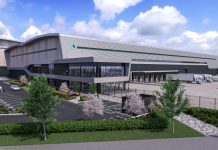A restored 18th century mill complex in Leicester is acting as a catalyst for ambitious plans to regenerate the city’s waterside over the next ten years.
Friars Mill, on the banks of the River Soar, has been transformed from a derelict site of empty factory buildings into a collection of modern workspaces for growing businesses.
The £7.1milllion, ERDF-backed redevelopment project has helped preserve Leicester’s oldest surviving factory building, which was nearly lost to fire on 2012.
While Friars Mill itself offers 15 workspaces over its 25,000 sq ft, demand for business accommodation on site is such that work to build two new office units was underway as final touches were being made to the restoration of the historic mill complex.
City Mayor Sir Peter Soulsby said: “Friars Mill is a wonderful collection of buildings and I am very proud that we were able to bring them back into meaningful and fitting use.
“The project has helped preserve a fascinating chapter in the city’s industrial heritage by creating really attractive, modern workspaces where businesses can grow and build a prosperous future.
“Friars Mill will be a beacon of the wider regeneration of the Waterside area, and shows what is possible.”
An ambitious vision for the multi-million pound transformation of around 60 hectares of land around the city’s river has already been set out.
Over the next ten years, the city council will work with developers to redevelop Waterside into a thriving place to live, visit and do business in, and reconnect Leicester to its waterfront.
Sir Peter added: “Waterside has the potential to be one of the most exciting large-scale regeneration opportunities in the East Midlands.
“We are moving forward with ambitious long-term vision to transform Waterside into a thriving neighbourhood with great places to live, space for businesses to flourish and attractive links between the riverside and nearby city centre.”
The demand and interest in the area is clear. An architectural competition to find a new use for a quirky little two-acre island in the middle of Waterside received over 80 entries, including ideas from as far afield as Japan, Spain, Hong Kong, Italy and America.
Back at Friars Mill, almost half of the available units were reserved before the development had even opened its doors.
Scott Knowles, chief executive of the East Midlands Chamber, said: “We’re very excited to be managing Friars Mill. It is a very prestigious site in a wonderful location. It combines elements of the city’s industrial heritage with cutting-edge, modern design to create a truly unique place to do business.
“Leicester is famed for its ability to innovate and keep businesses at the front of the pack and we are confident that Friars Mill will help continue that industrial evolution. It is the first building block of regeneration in the area.”
Leicester is a city that is perfectly located for inward investment – in the centre of the UK, an hour from London by train and importantly the rail connection allows you to get to St Pancras and therefore a seamless onward connection into mainland Europe, which is crucial to most of today’s globally linked businesses. Leicester sits in the middle of its county, providing a natural gravitational pull for its 1 million plus workforce, and there’s a good transport network into the city centre.
The workforce is skilled and multi-cultural, another advantage for businesses that want to trade or develop international links.



















